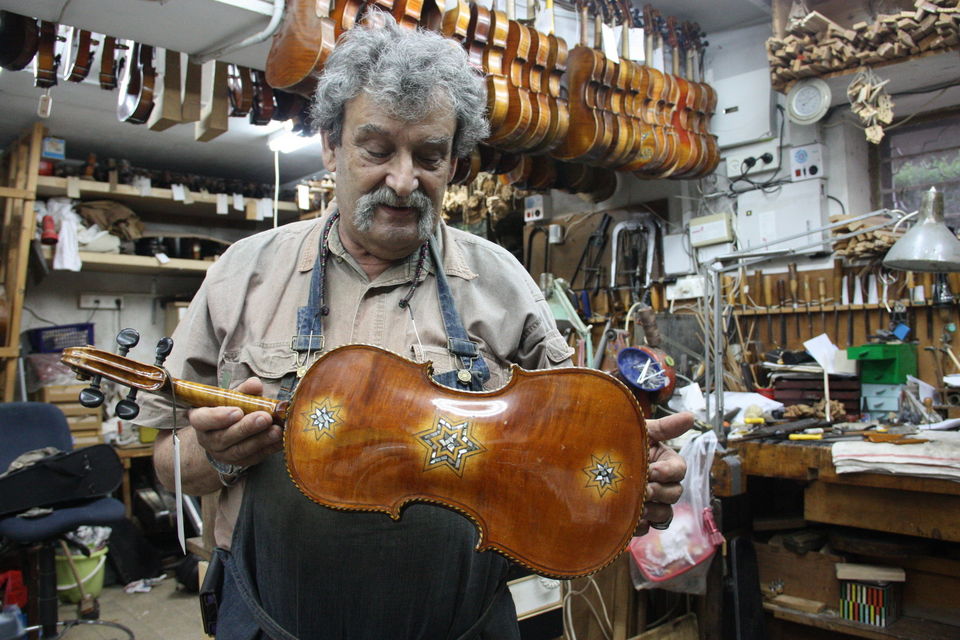04/26/2015
Instruments restored from Holocaust
- Share This Story
Violins of Hope: Instruments restored from Holocaust coming to Cleveland for wide-ranging cultural project

Photo by Debbie Yasinow
Article Reprinted with permission from Cleveland.com
By Zachary Lewis, The Plain Dealer
You can break bodies. You can extinguish voices. You can even rend souls, temporarily.
You cannot, however, silence music. Not with gas chambers. Not with firing squads. Not by means of starvation.
No, as a major exhibit and series of concerts featuring violins restored from the Holocaust will make poignantly clear in Cleveland this fall, music always survives. Even under horrific conditions, music unites, saves and transcends.
"It's a monument to all those who can't talk anymore," said Amnon Weinstein, the Israeli violinmaker at the heart of the project, titled "Violins of Hope."
"These violins, for me, represent six million people. To me, they say 'You cannot win. We are here.'"
Cleveland, and most of the world, has never seen anything like it. When "Violins of Hope" arrives in the fall, the project won't just showcase objects of inestimable value; some 25 instruments brought back to life from near ruin over the last 20 years. It also will tie together Northeast Ohio more securely than any cultural effort in recent history.
Details are still being finalized. In terms of scheduling, "Violins of Hope" remains a multimillion-dollar work in progress. The scope and cast of major players, however, have long been clear, and both, simply put, are remarkable.
In addition to an exhibit at the Maltz Museum of Jewish Heritage Oct. 1-Jan. 3, "Violins of Hope" will entail performances on the violins by the Cleveland Orchestra with conductor Franz Welser-Most, violinist Schlomo Mintz and artists from the Cleveland Institute of Music, as well as related coursework and public talks through Case Western Reserve University and an ever-expanding array of educational programs at area schools. WVIZ-PBS also will produce a documentary and broadcast the project's main events. A dedicated website, violinsofhopecle.org, is set to go live Sunday.
The goal, said organizer Dick Bogomolny, chairman of the orchestra's board of directors, is to stoke a visceral response to the Holocaust and thereby to open young eyes to contemporary genocidal threats.
By itself, he said, as history, the Holocaust "has about as much emotional appeal as the pharaohs and pyramids." Through Weinstein's violins, however, "we can use that story to make a powerful connection. The lessons of the Holocaust don't matter much without that. The carrying it forward is going to be the critical thing."
The appeal of the instruments is considerable, even from a distance, months ahead of their arrival in Cleveland. Long before it will be possible to behold or hear them, even to read of violins recovered from concentration camps and Holocaust survivors is to travel straight back in time, to imagine their former owners and to appreciate something of what those objects must have meant to them.
For those who played for their Nazi captors, the violin was a lifeline, a critical link to food and other supplies. For others, it was an escape mechanism. Through music, prisoners enjoyed momentary respites from omnipresent terror and misery. One brave soul even used his violin case to carry out a bomb attack. Those who literally escaped, meanwhile, often ceased playing, viewing their violins as little more than painful reminders.
Imagine, then, how Weinstein – who lost relatives in the Holocaust and whose in-laws were among those depicted in the film "Defiance" – felt, and still feels, as the one charged with revitalizing the instruments. For him, to handle such objects and encounter all the ways in which they and, by extension, their owners, were mistreated, is to experience waves of conflicting emotion: revulsion and curiosity, sorrow and elation, frustration and pride.
"You're holding the soul of somebody," Weinstein said. "You're touching this thing and you're thinking, 'Ay, ay, why can't you talk to me? You've seen the worst scenery in human history.'
"But then you have to do your job. You have to show that people resisted the Nazis with their violins. You have to show that there was another kind of resistance. The power of this little, 350-gram (3/4-lb.) instrument is incredible."
Cleveland is not the first to host "Violins of Hope." Earlier this year, the Berlin Philharmonic gave a high-profile concert on the instruments, and in 2012, a smaller collection than will be shown here was displayed in Charlotte, North Carolina. Detailed stories of the violins also have been compiled into a book by James Grymes, consulting curator of the Maltz exhibit.
Still, the Northeast Ohio version is certain to be in a class by itself. In no other place will so many of the violins find their way into the hands of musicians, or will such a broad effort be made to engage children and the public.
"It'll be unique, there's no question," said philanthropist and onetime violinist Milton Maltz, a lead supporter of the project along with his wife, Tamar. "We knew from the outset this was going to be something very, very special. It's something we're very honored to be involved with."

